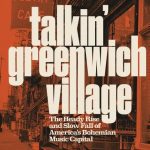THE READING ROOM: Artifacts and Essays Converse to Tell Bob Dylan Story in ‘Mixing Up the Medicine’

Just over a decade ago, in 2011, Bob Dylan remarked: “Everybody knows by now that there’s a gazillion books on me either out or coming out in the near future. So I’m encouraging anybody who’s ever met me, heard me or even seen me, to get into the action and scribble their own book. You never know, somebody might have a great book in them.”
Little did he know he could have easily been describing Bob Dylan: Mixing Up the Medicine, written and edited by Mark Davidson and Parker Fishel. This new book showcases the treasure trove of artifacts in the Bob Dylan Archive, housed in the Bob Dylan Center in Tulsa, Oklahoma (ND story).

Bruce Langhorne’s tambourine, the inspiration for Bob Dylan’s song “Mr. Tambourine Man.” (Courtesy of the Bob Dylan Center)
Since Bob Dylan contains multitudes, it is fitting that the volume approaches him from a multitude of angles, with essays from 30 writers including, among others, music and cultural critics such as Greil Marcus, Amanda Petrusich, Anne Margaret Daniel, and Greg Tate; musicians such as Richard Hell and Allison Moorer; and the poet Joy Harjo. The essays form the backdrop, though, to the photographs, letters, printed song lyrics, notebook entries, concert posters, and other ephemera featured.
“Dylan’s oeuvre has proved itself to be dynamic and evolving, his restless creativity in search of the heart of a song,” Davidson, curator of the Bob Dylan Archive and the director of archives and exhibitions for the Bob Dylan and Woody Guthrie centers in Tulsa, and Fishel, an archivist who served as co-curator of the inaugural exhibitions at the Bob Dylan Center, write in the book’s introductory essay. “And as he has continually set trends only to break them, Dylan himself has also become a subject of endless fascination. Often made out to be a cipher for his music, Dylan has pushed against that interpretation — or any other, for that matter — making an art of reinvention while consistently taking risks and defying expectations. As an artist, Bob Dylan remains beholden only to his muse, his sights kept firmly fixed on the horizon line.”
Bob Dylan: Mixing Up the Medicine is divided into chronologically into sections that run from the singer’s childhood and his journey down Highway 61 into New York to his latest album, Rough and Rowdy Ways, and the last few years. The section titled “The Constant State of Becoming,” for example, covers the years 1974 to1978. Full-page color spreads of Dylan and The Band on their 1973 and 1974 tours greet readers at the opening of the chapter. As in other chapters, Dylan memorabilia — ticket stubs, handwritten drafts of lyrics, photos of Dylan in candid or staged shots, covers of albums and singles — adorn every page, and short summary descriptions give context to Dylan’s albums released during these years: Planet Waves, Before the Flood, Blood on the Tracks, The Basement Tapes, Desire, Hard Rain, Street Legal, and Bob Dylan at Budokan. During the making of Desire, his 17th studio album, Dylan “began writing songs with an eye towards assembling a band when serendipity took its course.” In an unpublished manuscript, Dylan writes “Scarlet [Rivera] was crossing 2nd Avenue and Rob Stoner was playing with Bobby Neuwirth. Jacques Levy was standing on Bleecker St. and we went and wrote up a lot of songs in a short time. Marta Orbach was talking about Joey Gallo and I was thinking about Hurricane Carter. Emmylou [Harris] came by and we sang ‘Oh, Sister’ and ‘Catfish’ was tried at least once a night.”
In this same chapter, Harjo, the 23rd Poet Laureate of the United States, reflects on “Tangled Up in Blue”: “these ‘Tangled Up in Blue’ lyrics make a kind of equation of memory. Words are given momentum by emotional fervor. Each soul exists in shimmering memory, and memory does not stand still. It is constantly moving within us, through us, with or without us, so that we are ultimately creations of time. Perhaps memory has created us, perhaps it shifts time by an ache of loneliness or a sigh of awe at unbelievably beauty found in a bar at the edge of nowhere, or at the click of a key in the ignition to say goodbye to goodbye when we had just made love to a miracle.”
In the book’s final essay, historian Douglas Brinkley captures culture’s enduring fascination with Dylan: “As assuredly as Dylan has been reimagining himself since he recorded the original ‘Song to Woody’ in 1962, future musicians will be forever reinterpreting his timeless standards. Dylan changed the landscape of American popular music by melding his literary vision with folk tradition, blues, gospel, and rock idioms. Wherever Dylan performs live or records in the studio, mysterious music falls from the starry sky.”
Chock full of images and Dylan ephemera, Bob Dylan: Mixing Up the Medicine makes a perfect gift for any Dylan fan, illustrating the singer’s ever-evolving persona and the enigmatic ways he shapes his songs.

Bob Dylan at a press conference in Europe, 1966. Film still from 1966 European Tour footage, by D. A. Pennebaker. (Courtesy of The Bob Dylan Center)
Bob Dylan: Mixing Up the Medicine, written and edited by Mark Davidson and Parker Fishel, was published by Callaway on Oct. 24.




